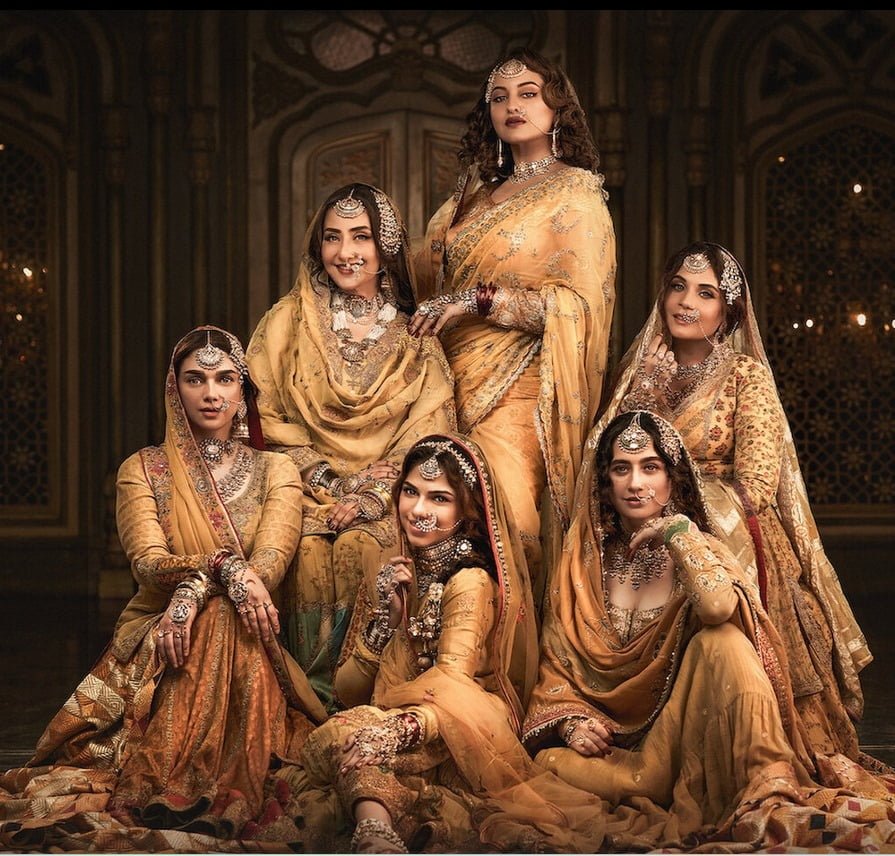“Heeramandi: The Diamond Bazaar” – A Tale of Freedom, Power, and Redemption

Review: “Heeramandi” – Sanjay Leela Bhansali’s Queen’s Gambit Pays Off
Remember when Sanjay Leela Bhansali made his first tryst with direction, with the songs of Vidhu Vinod Chopra’s 1994 romance 1942: A Love Story? When Manisha Koirala celebrated love, romance, rebellion, and freedom, levitating across lush greens with her luminescence. At the end of “Pyar Hua Chupke Se,” her union with a prince charming riding a horse is interrupted by a protest march for India’s independence. Now, 30 years later, Bhansali and Manisha reunite to tell another tale of freedom, personal and political, with his debut show, “Heeramandi: The Diamond Bazaar.”
The Netflix India original show reminds us how far the two artists have come in terms of honing their craft and carving out their identities. Manisha plays Mallika Jaan, the madam of a brothel in Heeramandi, a Lahore locality, during pre-independence India. The casting works instantly – the Manisha who lit up the screen in “Bahon Ke Darmiya,” the timeless melody from Bhansali’s 1996 directorial debut “Khamoshi: The Musical,” dances or sings reluctantly. She holds unabating pride in her past but is also decidedly stuck in that glory. With one expression, one gesture, we gauge the life she’s led, the triumphs she’s scored, and the innocence she’s lost. We don’t need Heeramandi to play out in linear biopic fashion like “Gangubai Kathiawadi” because shadows from their past sneak out from one corner of the Shahi Mahal or the other.
Setting the Stage: Heeramandi and its Women
Sanjay Leela Bhansali’s new Netflix series, “Heeramandi,” is here. The show stars Manisha Koirala, Sonakshi Sinha, Aditi Rao Hydari, and Fardeen Khan, among others. Set in the 1920s, the series revolves around Heeramandi and the women who own the nooks and corners of the palatial building. Amidst the crowd and chaos, there is a system and hierarchy in place. At the top of the family tree is Mallika Jaan (Manisha Koirala), who is the matriarch of Heeramandi. She is the queen bee, and the others vie for her attention. Mallika Jaan is not to be toyed with, and Bhansali establishes that in the very first episode. Raw, unfiltered yet authentic and very protective of her clique, Mallika Jaan’s character comes to life because Manisha Koirala delivers one of her career-best performances. She surrenders herself to Bhansali’s vision and follows every beat perfectly. Perhaps the best-written character arc amongst women, she shines as bright as the diamonds hanging from her ears.
Sonakshi Sinha essays the double role of Fareedan/Rehana and is the nemesis who is out to destroy Mallika. There is history between these two women, and scores have to be settled. But the task isn’t easy. Obstructing her path are Mallika’s nautch girls Lajjo (Richa Chadha), Waheeda (Sanjeeda Shaikh), Bibbo (Aditi Rao Hydari), and her very own daughter Alamzeb (Sharmin Segal Mehta). Almost like a game of chess, these women are ferociously chasing their dreams. Some want revenge, others attention from an estranged lover, another seeks to change the path of her destiny.
Bhansali’s Men: Tyrants and Battles
Bhansali has a knack for painting his men in equally interesting shades as his women. In Heeramandi, the men too have battles to fight. Tajdar (Taha Shah) seeks to fight for his love and his country, while Wali Mohammad (Fardeen Khan) is a man who realizes he is destroyed in love. Bhansali’s men are also tyrants – there is Cartwright (Jason Shah), who leaves no stone unturned to humiliate and break the ego of Mallika Jaan and her clan.
Bhansali wastes no time in Heeramandi. Every scene has a purpose, yet there are no narrative fillers. Each scene leaves you with a dialogue to remember, a frame to freeze in your mind, or a moment to applaud. The freedom struggle looms large over the plot, but it doesn’t spawn sermons. There are ripples of the rebellion throughout the show, but the majority of the eight episodes are invested in the game of one-upmanship between all the tawaifs – mother-daughter, sisters, and even aunt-niece.
The plot has the spice of a saas-bahu opera, but with the finishing of a taut prestige drama. And the tone works wonders – through the kotha politics, Bhansali achieves a dual goal – of saucing up a lavish feast and drawing an analogy to India’s freedom struggle. Divide and rule wasn’t always the British’s ammunition – like the tawaifs, Indians were too busy with their historical, intergenerational infighting to rise above their vested interests for a macro mutiny.
Ambitious Scale and Flaws
Heeramandi is mounted on a huge scale. Parallel to the story of these women runs the track of independence from British rule and the simmering fire of revolution. A case of being over-ambitious, Bhansali’s weakest scenes and lowest points in the series come when the characters are torn between the two. Another flaw in the series is its pace. Some scenes feel over-indulgent, and the jump cuts from present to past storylines get slightly confusing.




Appreciate tthe recommendation. Let me try it
out. https://odessaforum.biz.ua/
Appreciate the recommendation. Let me try it out. https://odessaforum.biz.ua/